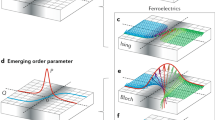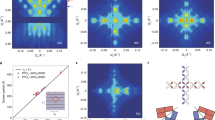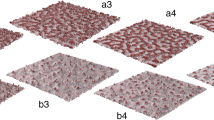Abstract
The characteristic functionality of ferroelectric materials is due to the symmetry of their crystalline structure. As such, ferroelectrics lend themselves to design approaches that manipulate this structural symmetry by introducing extrinsic strain. Using in situ dark-field X-ray microscopy to map lattice distortions around deeply embedded domain walls and grain boundaries in BaTiO3, we reveal that symmetry-breaking strain fields extend up to several micrometres from domain walls. As this exceeds the average domain width, no part of the material is elastically relaxed, and symmetry is universally broken. Such extrinsic strains are pivotal in defining the local properties and self-organization of embedded domain walls, and must be accounted for by emerging computational approaches to material design.
This is a preview of subscription content, access via your institution
Access options
Access Nature and 54 other Nature Portfolio journals
Get Nature+, our best-value online-access subscription
$29.99 / 30 days
cancel any time
Subscribe to this journal
Receive 12 print issues and online access
$259.00 per year
only $21.58 per issue
Buy this article
- Purchase on Springer Link
- Instant access to full article PDF
Prices may be subject to local taxes which are calculated during checkout




Similar content being viewed by others
References
Freedman, D. A., Roundy, D. & Arias, T. A. Elastic effects of vacancies in strontium titanate: Short- and long-range strain fields, elastic dipole tensors, and chemical strain. Phys. Rev. B 80, 064108 (2009).
Chu, M.-W. et al. Impact of misfit dislocations on the polarization instability of epitaxial nanostructured ferroelectric perovskites. Nat. Mater. 3, 87–90 (2004).
Hÿtch, M. J., Snoeck, E. & Kilaas, R. Quantitative measurement of displacement and strain fields from HREM micrographs. Ultramicroscopy 74, 131–146 (1998).
Choudhury, S., Li, Y. L., Krill, C. III & Chen, L.-Q. Effect of grain orientation and grain size on ferroelectric domain switching and evolution: Phase field simulations. Acta Mater. 55, 1415–1426 (2007).
Schlom, D. G. et al. Strain tuning of ferroelectric thin films. Annu. Rev. Mater. Res. 37, 589–626 (2007).
Budimir, M., Damjanovic, D. & Setter, N. Enhancement of the piezoelectric response of tetragonal perovskite single crystals by uniaxial stress applied along the polar axis: A free-energy approach. Phys. Rev. B 72, 064107 (2005).
Noheda, B. et al. Polarization rotation via a monoclinic phase in the piezoelectric 92%PbZn1/3Nb2/3O3-8%PbTiO3. Phys. Rev. Lett. 86, 3891–3894 (2001).
Tagantsev, A. K. Piezoelectricity and flexoelectricity in crystalline dielectrics. Phys. Rev. B 34, 5883–5889 (1986).
Chu, K. et al. Enhancement of the anisotropic photocurrent in ferroelectric oxides by strain gradients. Nat. Nanotech. 10, 972–979 (2015).
Goncalves-Ferreira, L., Redfern, S. A. T., Artacho, E., Salje, E. & Lee, W. T. Trapping of oxygen vacancies in the twin walls of perovskite. Phys. Rev. B 81, 024109 (2010).
Chen, C.-C. et al. Three-dimensional imaging of dislocations in a nanoparticle at atomic resolution. Nature 496, 74–77 (2013).
Kalinin, S. V. & Bonnel, D. A. Imaging mechanism of piezoresponse force microscopy of ferroelectric surfaces. Phys. Rev. B 65, 125408 (2002).
Farooq, M. U. et al. Using EBSD and TEM-Kikuchi patterns to study local crystallography at the domain boundaries of lead zirconate titanate. J. Microsc. 320, 445–454 (2008).
Tagantsev, A. K., Cross, L. E. & Fousek, J. Domains in Ferroic Crystals and Thin Films (Spinger, NewYork, NY, 2010).
Uchino, K. Ferroelectric Devices (CRC Press, Boca Raton, FL, 2009).
Hruszkewycz, S. O. et al. Imaging local polarization in ferroelectric thin films by coherent X-ray Bragg projection ptychography. Phys. Rev. Lett. 110, 177601 (2013).
Lummen, T. T. A. et al. Thermotropic phase boundaries in classic ferroelectrics. Nat. Commun. 5, 3172 (2014).
Rogan, R. C., Tamura, N., Swift, G. A. & Üstündag, E. Direct measurement of triaxial strain fields around ferroelectric domains using X-ray microdiffraction. Nat. Mater. 2, 379–381 (2003).
Simons, H. et al. Dark-field X-ray microscopy for multiscale structural characterization. Nat. Commun. 6, 6098 (2015).
Cayron, C. Quantification of multiple twinning in face centred cubic materials. Acta Mater. 559, 252–262 (2011).
Catalan, G. et al. Flexoelectric rotation of polarization in ferroelectric thin films. Nat. Mater. 10, 963–967 (2011).
Locherer, K. R., Chrosch, J. & Salje, E. K. H. Diffuse X-ray scattering in WO3. Phase Transit. 67, 51–63 (1998).
Simons, H., Jakobsen, A. C., Ahl, S. R., Detlefs, C. & Poulsen, H. F. Multiscale 3D characterization with dark-field X-ray microscopy. MRS Bull. 41, 454–459 (2016).
Arlt, G. The influence of microstructure on the properties of ferroelectric ceramics. Ferroelectrics 104, 217–227 (1990).
Salje, E. K. H., Li, S., Stengel, M., Gumpsch, P. & Ding, X. Flexoelectricity and the polarity of complex ferroelastic twin patterns. Phys. Rev. B 94, 024114 (2016).
Ahluwalia, R. et al. Manipulating ferroelectric domains in nanostructures under electron beams. Phys. Rev. Lett. 111, 165702 (2013).
Novak, J., Bismayer, U. & Salje, E. K. H. Simulated equilibrium shapes of ferroelastic needle domains. J. Phys. Condens. Matter 14, 657 (2002).
Harrison, R. J. & Salje, E. K. H. Ferroic switching, avalanches, and the Larkin length: Needle domains in LaAlO3. Appl. Phys. Lett. 99, 151915 (2011).
Cheng, C. E. et al. Revealing the flexoelectricity in the mixed-phase regions of epitaxial BiFeO3 thin films. Sci. Rep. 5, 8091 (2005).
Zhang, R., Jiang, B. & Cao, W. Orientation dependence of piezoelectric properties of single domain 0.67(Mg1/3Nb2/3)O3-0.33PbTiO3 crystals. Appl. Phys. Lett. 82, 3737–3739 (2003).
Kwei, G. H., Lawson, A. C., Billinge, S. J. L. & Cheong, S. W. Structures of the ferroelectric phases of barium titanate. J. Phys. Chem. 97, 2368–2377 (1993).
Daniels, J. E. et al. Heterogeneous grain-scale response in ferroic polycrystals under electric field. Sci. Rep. 6, 22820 (2016).
Marincel, D. M. et al. Influence of a single grain boundary on domain wall motion in ferroelectrics. Adv. Funct. Mater. 24, 1409–1417 (2014).
Bintachitt, P., Trolier-McKinstry, S., Seal, K., Jesse, S. & Kalinin, S. V. Switching spectroscopy piezoresponse force microscopy of polycrystalline capacitor structures. Appl. Phys. Lett. 94, 042906 (2009).
Rojac, T. et al. Domain-wall conduction in ferroelectric BiFeO3 controlled by accumulation of charged defects. Nat. Mater. 16, 322–327 (2017).
Aschauer, U., Pfenniger, R., Selbach, S. M., Grande, T. & Spaldin, N. Strain-controlled oxygen vacancy formation and ordering in CaMnO3. Phys. Rev. B 88, 054111 (2013).
Daniel, L., Hall, D. A. & Withers, P. J. A multiscale model for reversible ferroelectric behavior of polycrystalline ceramics. J. Mech. Mater. 71, 85–100 (2014).
Horstmeyer, M.F. Integrated Computational Materials Engineering (ICME) for Metals: Using Multiscale Modeling to Invigorate Engineering Design with Science (Wiley, Hoboken, NJ, 2012)
Eriksson, M., van der Veen, J. F. & Quitmann, C. Diffraction-limited storage rings. J., Synchrotron Radiat. 21, 837–842 (2014).
Vaughn, G. B. M. et al. X-ray transfocators: focusing devices based on compound refractive lenses. J. Synchrotron Rad. 18, 125–133 (2011).
Stöhr, F. et al. Sacrificial structures for deep reactive ion etching of high-aspect ratio kinoform silicon x-ray lenses. J. Vac. Sci. Technol. B 33, 062001 (2015).
Poulsen, H. F. et al. X-ray diffraction microscopy based on refractive optics. J. Appl. Cryst. 50, 1441–1456 (2017).
Maranganti, R. & Sharma, P. Atomistic determination of flexoelectric properties of crystalline dielectrics. Phys. Rev. B. 80, 054109 (2009).
Acknowledgements
We are grateful to the European Synchrotron for providing beamtime at ID06, and Danscatt for financial assistance related thereto. This work is supported by the ERC Advanced grant ‘d-TXM’ (291321). In addition, H.S. and A.B.H. are supported by individual postdoc grants from the Independent Research Fund Denmark (DFF–4093-00296 and DFF–6111-00440). The work of D.D. has been supported by the Swiss National Science Foundation (grant no. 200021-159603), while J.E.D. acknowledges financial support from the ARC Discovery Projects DP120103968 and DP130100415. The silicon compound refractive lenses used in the experiment were manufactured at DTU Danchip, National Center for Micro- and Nanofabrication.
Author information
Authors and Affiliations
Contributions
A.B.H. and H.S. prepared the samples. H.S., A.C.J., C.D. and M.M. performed the experiments. F.S. developed the X-ray optics for the experiment. S.S. developed the noise-reduction algorithm used in the analysis. H.S. designed the experiment with D.D. and J.E.D. H.S. performed the analysis, then interpreted the data with D.D., J.E.D. and H.F.P. H.S. wrote the article and all authors contributed and commented on the text.
Corresponding author
Ethics declarations
Competing interests
The authors declare no competing interests.
Additional information
Publisher’s note: Springer Nature remains neutral with regard to jurisdictional claims in published maps and institutional affiliations.
Supplementary information
Supplementary Information
Supplementary Video Captions 1–3, Supplementary Figures 1–2
Supplementary Video 1
Dark-field X-ray microscopy intensity images showing the evolution of a group of domains at a single position in reciprocal space (that is, a single lattice orientation and strain) during in situ electric field application from 0 to 472 V mm–1. Local changes in the observed intensity are due to domain entering and exiting the Bragg condition as their lattice orientation and strain locally changes in response to the applied electric field. The image exposure time is 1 second.
Supplementary Video 2
As above, but during in situ electric field application from 472 V mm–1 to 944 V mm–1. Note the inhomogeneous switching event between 33 and 38 seconds. The image exposure time is 1 second.
Supplementary Video 3
As above, but during the reduction of the in situ electric field from 944 V mm–1 to 0 V mm–1. Note the relatively constant process of domain back-switching during the process. The image exposure time is 1 second.
Rights and permissions
About this article
Cite this article
Simons, H., Haugen, A.B., Jakobsen, A.C. et al. Long-range symmetry breaking in embedded ferroelectrics. Nature Mater 17, 814–819 (2018). https://doi.org/10.1038/s41563-018-0116-3
Received:
Accepted:
Published:
Issue Date:
DOI: https://doi.org/10.1038/s41563-018-0116-3
This article is cited by
-
Extensive 3D mapping of dislocation structures in bulk aluminum
Scientific Reports (2023)
-
Simultaneous bright- and dark-field X-ray microscopy at X-ray free electron lasers
Scientific Reports (2023)
-
Three-dimensional imaging of grain boundaries via quantitative fluorescence X-ray tomography analysis
Communications Materials (2022)
-
Analytical methods for superresolution dislocation identification in dark-field X-ray microscopy
Journal of Materials Science (2022)
-
Formation and annihilation of stressed deformation twins in magnesium
Communications Materials (2021)



